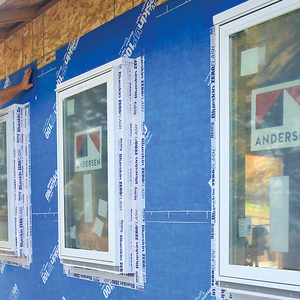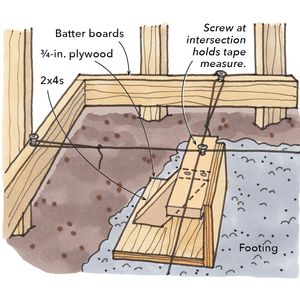Hi Everyone,
This is my first time on the breaktime discussion board and I am posting this message out of desperation. I hope someone can help us! About one year ago my husband and I had ColorMaker concrete floors installed into our brand new home. It turns out they were not installed properly; we are lacking the wire mesh that is supposed to be put down prior to the concrete pour. About two months after installation the floors began cracking. Now, they are in terrible shape and we are only one year out! We are beginning to dislike the floors a great deal but are stumped about our options. Aside from pursuing the installer, who has still not made it out here to even look at the floors since, what can we do? We are looking to rectify, get rid of, or cover these floors- any advice is greatly appreciated. <!—-><!—-> <!—->



















Replies
no hydronic heat in the floor?
A great place for Information, Comraderie, and a sucker punch.
Remodeling Contractor just outside the Glass City.
Quittin' Time
Hi.
We do have radiant heat in the floor. Is that a factor in the cracking?
L, We need some more information. There is no concrete that is that thin. Give the size of the joists and the span (since it appears the substance is over a wood frame), the thickness of subfloor and whether or not the subfloor was glued and screwed to the joists.
I'll re-read your first post but am I remembering this was a new house? If so, where's the builder?
edit: I checked out the colormaker site. I didn't spend much time but it appears they do have a thin overlay, but that is for over an already existing concrete floor. To put that on a wood subfloor would be ludicrous at best.
The radiant is installed how? Hydronic hose below the subfloor or did they use an electric mat in that thin colormaker product?
A great place for Information, Comraderie, and a sucker punch.
Remodeling Contractor just outside the Glass City.
Quittin' Time
Edited 6/1/2006 4:50 pm ET by calvin
LM ... we need a little more info. Where are you located? Is the foundation of the house a concrete slab, or do you have wood joists over a basement or crawl space? Wait ... you said the nail heads are showing through? Sounds like the floor is deflecting too much and the topping is failing. If that's the case, then it sounds like the installed did not properly plan the job.
"When asked if you can do something, tell'em "Why certainly I can", then get busy and find a way to do it." T. Roosevelt
We are located in York, Maine.
the foundation of the house is wood joists over a basement .
The nail heads are most definitely showing through. :(
you are just down the raod from me a couple of hours. Did you get hit by flooding in the last couple weeks? Water inthe basement would have caused swelling in your subfloor leading to all of the symptoms you describe tooo, but I think you have just been stuck with the wrong material and or an inappropriate installation.Was the installer one who specializes in this sort of product or was it a one-off kind of job for him? maine has a bunch of guys with good work ethic, but there are way too many hacks too. reading the instructions is an idea they laugh off
Welcome to the Taunton University of Knowledge FHB Campus at Breaktime. where ... Excellence is its own reward!
We didn't actually get water in our basement at all. Everything besides our flooring is great in our house!! I think you are right about being stuck with the wrong material and or an inappropriate installation.
I would say the installer was one who thought he knew what he was doing, had done small jobs in the past, and bit off more than he could chew. he's terrible.
the size of the joists = 2' by 10' or 12' and the span= 16"
the thickness of subfloor = advantech glued and screwed and probably 3/4" thick
concrete backerboard was 1/2"
This is a new house and the builder is in York, Maine, where the house is. The builder did not do the floors though...
The radiant is Hydronic hose below the subfloor
let me help you clarify some confusing information you just gave-you wrote; "size of the joists = 2' by 10' or 12' and the span= 16""Which reads, The size of the joists is two feet by ten feet or twelve feet, and the span is sixteen inches."A span is the length of the joist, so that must be sixteen feet long?
A layout is typical at sixteen inches on center, written 16"OCYou joists must be 2"x10" ( or 2"x12") which actually measure 1-1/2" by 9-1/4"Right?
Welcome to the Taunton University of Knowledge FHB Campus at Breaktime. where ... Excellence is its own reward!
are you saying 2x10s on 16 inch centers, with a joist length of about 12 feet?
Sorry to hear about your troubles. How thick are your floors? Sounds like more than a missing wire problem to me.
Hi.
The floors are very thin. The actual concrete is probably 1/16 of an inch. Under that there is the subfloor, which is standard width...i think!
1/16" thick.......really?If this is true, then it's not concrete. What is it?
Perhaps I was wrong. My husband thinks it may be 1/8" thick, but not thicker. After reading all of the postings I think the wrong product was used...
Call your attorney
Here in Ct all work is covered by a minimum one year warrantee. If the same is true for your area? (fill out your profile) the installer may be buying time
Ok if a floor is done half way right, there is no need for wire mesh. I myself refused to use wire mesh. Some are going to say all concrete cracks. that is a wrong answer. that is from people that are too lazy to do a quality job.
The point I trying to make is. if a slab cracks and gets bigger than 1/8 inch. I like to say 1/16 but giving a little. The foundation is settling. If you have small cracks that doesnt open up. just cover with a clear poly and they look great. give it character. but if the keep opening, well trouble.
Edited 5/30/2006 11:08 pm by brownbagg
HI.
What sort of clear poly do you recommend? The cracks are where the backing is underneath and now the nail holes that are holding the backing to the subfloor are cracking up too, so we have little broken circles everywhere.
I think you got snookered. You definitely should file a suit, but I wouldn't expect to recover much -- the installer is probably packing his bags for Bermuda as we speak.
Probably the simplest "fix" is to cover the existing with new underlayment, and then put down vinyl or some such. It may be that you could put down carpet or "floating" plank flooring without a new underlayment, but you'd want to be sure that chunks of the existing mess aren't apt to pop loose and create a high spot in the floor.
Take a picture of the cracks, so we can say/see--
They are minor
The cracks follow the raiant heat lines
The concrete is subpar
Its settleing
Tear it out
It's a bad job
I'm having trouble posting the pictures. If you could see them, you'd see that the nailheads are breaking through. The floor cracks on the seam of the backer board, not the hydronic hose.
The lesson to be learn in pouring any concrete is that uneven curing will cause it to crack.
If half is is on dirt and part on concret it will crack. Mesh too close to the surface, it will crack. Half sun and shade, it will crack. Two seperate pours, it will crack.
Your first call should be to a lawyer. Your next stop might be the building department. Your third call should be to a local contractor that does concrete repairs.
blue
Since I had never heard of such a product before and since it seemed to go against common sense, I did some gogling and chased some leads 'cause one reason I am here is to learn.
First - Every lead or link I saw to the oolormaster website is now inactive, bringing up messages that it could not be found....that's not a goood sign.
There were sites describing generlly what they do with this product. I can't be sure, but it sounds like it is ####topping poish intended to be applied over a concrete slaab or gypsum floor.
If that is right, it was never intended to be pplied ove a wood subfloor as you have, which would explain some of the confusion maany opf us have here.
I suggest that you have been taken to th ecleaners on this deal and thqt you shouldcontact
A lawyer
state atty general
local newspaper if they have a consumer help line column
start making plansfor what the new floor will be, seeking out reputaatble contractors, but thoroughly photograaph and document the existing cconditions and the timesand dates you have attempted to contaact the offensive 'contractor'
IMO, it would be a long shot to expect any positive resolution on this.
Welcome to the
Taunton University of Knowledge FHB Campus at Breaktime.
where ...
Excellence is its own reward!
Are you sure you used the correct name.I used -ColorMaker concrete floors- and gothttp://www.colormakerfloors.com/products.shtmlSeems to be very active.But all of their products are designed to go over existing concrete as top or resurfacing materials. From "paper thin to 3/8".They appear to be a supply. The HO should contact them, at least to alter them an installer mis using the product, as they do training and showcase installers.Now JLC had this article;"First 100 Words:
Decorative Floors With Polymer Overlays Tom Ralston These thin toppings make it possible to create colored concrete surfaces over existing slabs and wood-framed floors Tradesmen have been applying decorative finishes to freshly placed concrete for as long as the material has existed (see "Decorative Concrete," 1/03). By coloring and texturing concrete surfaces, skilled applicators can produce concrete floors that are indistinguishable from stone, brick, tile, and slate. Dyes and stains can create murals or abstract patterns while maintaining the look and texture of a monolithic pour. The color typically goes into the surface of the concrete, so the finished product "http://tinyurl.com/mrvkaHe installed over wood and concrete floors. But IIRC is was something in the range of 3/8 ot 3/4"
Technically, you're supposed to be able to do what the OP wanted. But as he also says, it was done without the mesh. That's the critical part - along with reducing the deflection.
Sounds to me as if it was done by a hack.
But some of these concrete toppings are supposed to take a lot of flex. IF applied correctly. Which ultimately, over a subfloor, 3/4 exterior ply, and 15# paper would be another 3/4" thick.
It is ColorMaker and now that I've read what you wrote I'm thinking that the wrong product was used for this job.
Sounds like an interesting product if it's installed correctly...
But it's hard for me to picture a mesh that can lay flat enough and be thin enough to go in a 1/8" thick layer or coating.
After looking around on their web site I think the product that is used on framed floors is supposed to be applied over gypcreat - or light wehigh concrete - as they called it. I was disapointed that they did not have installation instructions on the web.